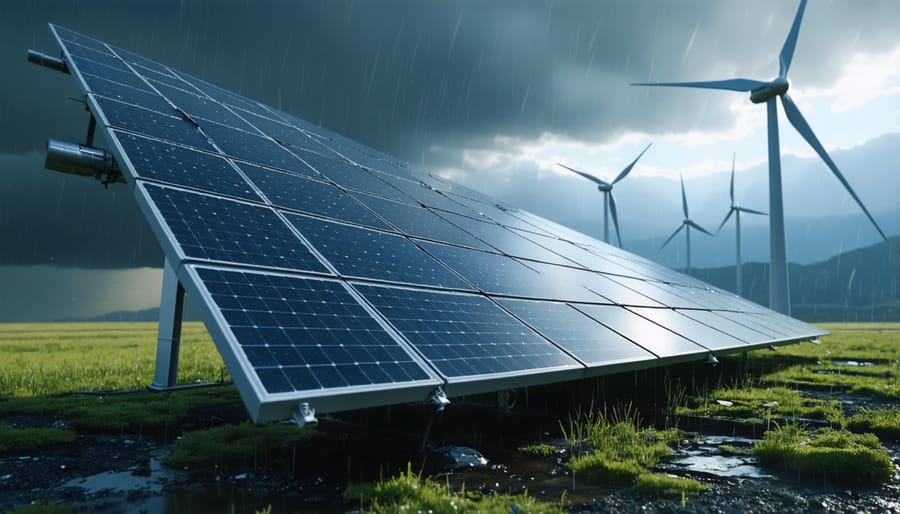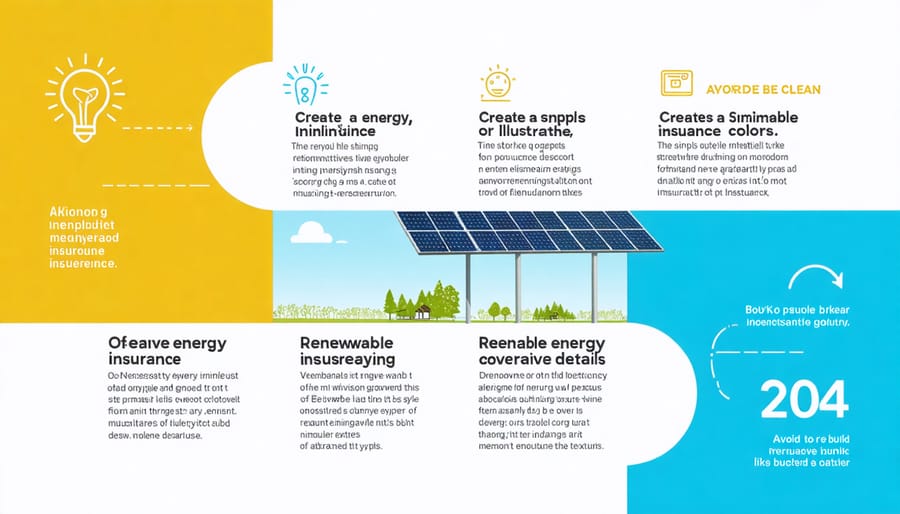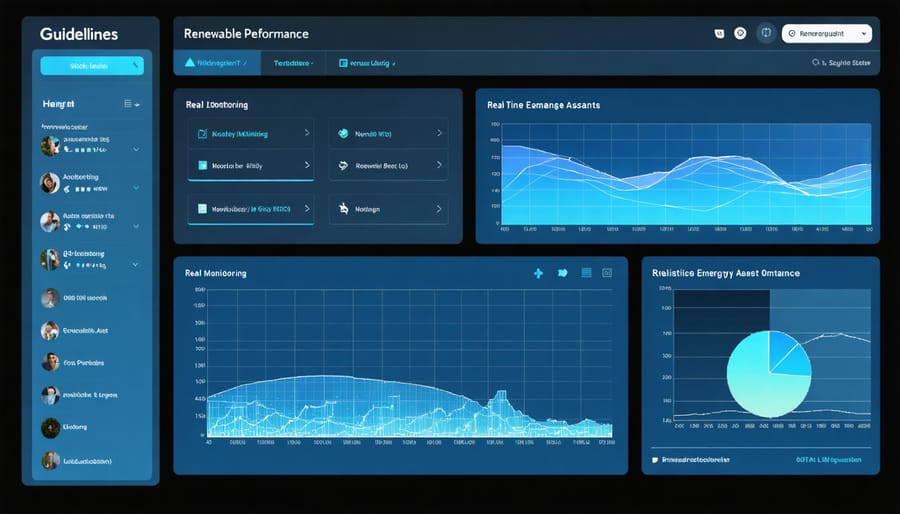In today’s rapidly evolving energy landscape, the strategic management of renewable energy assets has become a cornerstone of sustainable business operations and investment success. As global renewable energy installations surge past $500 billion in annual investments, effective asset management emerges as the critical factor separating profitable ventures from underperforming ones.
Professional asset management of renewable energy infrastructure encompasses sophisticated performance monitoring, predictive maintenance strategies, and data-driven operational optimization – all working in concert to maximize both energy output and financial returns. From utility-scale solar farms to distributed wind installations, these assets require specialized expertise to navigate complex regulatory environments, optimize power purchase agreements, and maintain peak operational efficiency.
For property owners and investment managers, understanding the nuances of renewable energy asset management isn’t just about maintaining equipment – it’s about protecting and enhancing the value of increasingly significant clean energy investments. Modern asset management platforms combine IoT sensors, artificial intelligence, and advanced analytics to deliver real-time insights that drive performance improvements and reduce operational risks.
This paradigm shift in energy asset management creates unprecedented opportunities for stakeholders who can effectively leverage these tools and strategies to optimize their renewable energy portfolios.
Key Risks Facing Renewable Energy Assets
Weather-Related Risks
Renewable energy installations face significant weather-related risks that can impact their performance and longevity. Solar panels are particularly vulnerable to hail damage, which can crack or shatter the panels’ surface, while heavy snow accumulation can reduce energy production and potentially cause structural stress. Strong winds pose a dual threat – they can damage solar panel mounting systems and cause turbine blade failures in wind farms.
Coastal installations face additional challenges from salt spray corrosion and hurricane exposure, while inland facilities must contend with tornado risks and extreme temperature fluctuations. These temperature swings can affect solar panel efficiency and strain mechanical components in wind turbines. Lightning strikes present another significant concern, potentially causing electrical system damage and fire risks across all renewable installations.
To maintain asset value and ensure consistent energy production, property owners should implement comprehensive monitoring systems and regular maintenance schedules. Installing weather stations on-site can provide early warnings for severe conditions, allowing operators to adjust equipment positioning or activate protective measures when necessary. This proactive approach helps minimize weather-related downtime and extends the operational life of renewable energy assets.

Operational and Performance Risks
Renewable energy assets face several operational challenges that can impact their performance and financial returns. Equipment failure is a primary concern, particularly for solar panels and wind turbines exposed to harsh weather conditions. Regular wear and tear, manufacturing defects, or extreme environmental factors can lead to unexpected breakdowns, resulting in significant downtime and revenue loss.
Performance degradation is another crucial risk factor. Solar panels typically lose efficiency over time, with an average annual degradation rate of 0.5% to 1%. Wind turbines may experience reduced output due to mechanical issues or changes in wind patterns. These gradual declines in performance can substantially impact long-term energy production and return on investment.
Maintenance issues present ongoing challenges for asset managers. Remote locations, specialized equipment requirements, and the need for qualified technicians can make repairs costly and time-consuming. Preventive maintenance programs are essential but require careful planning and budgeting. Additionally, supply chain disruptions can affect spare parts availability, potentially extending equipment downtime and increasing operational costs.
To mitigate these risks, asset managers should implement robust monitoring systems, maintain detailed maintenance records, and establish relationships with reliable service providers.

Essential Insurance Coverage Types
Property and Equipment Coverage
Insurance coverage for renewable energy equipment and property requires careful consideration of both standard and specialized policies. Physical asset protection typically encompasses solar panels, wind turbines, energy storage systems, and associated infrastructure against various risks including natural disasters, equipment breakdown, and theft.
Property owners should seek comprehensive coverage that includes both equipment breakdown insurance and property damage protection. This dual approach ensures protection against mechanical failures, electrical malfunctions, and physical damage from external factors. Most insurers offer specific endorsements for renewable energy systems that can be added to existing property insurance policies.
When selecting coverage, consider factors such as equipment replacement costs, business interruption coverage, and potential revenue loss during system downtime. Many policies now offer performance guarantee coverage, which protects against underperforming systems that don’t meet projected energy generation targets.
Regular maintenance requirements are often stipulated in insurance policies, so it’s essential to maintain detailed service records. Some insurers offer premium discounts for systems with advanced monitoring capabilities and proven maintenance protocols. Additionally, consider coverage for environmental risks, such as damage from lightning strikes or extreme weather events, which are increasingly common challenges for renewable energy installations.
Remember to review and update coverage limits annually, as equipment values and replacement costs can change significantly over time.
Business Interruption Insurance
Business interruption insurance plays a crucial role in protecting renewable energy investments by covering revenue losses during unexpected downtime. When solar panels, wind turbines, or other renewable energy systems experience operational interruptions, this specialized coverage helps maintain cash flow by compensating for lost income and ongoing expenses.
The coverage typically activates when facility operations are disrupted due to covered events such as equipment breakdown, severe weather damage, or other unforeseen circumstances. It can include compensation for lost power generation revenue, fixed operating costs, and even additional expenses incurred while getting systems back online.
For renewable energy asset managers, calculating appropriate coverage limits requires careful analysis of potential revenue losses and recovery timeframes. Key factors to consider include seasonal energy production patterns, power purchase agreement terms, and typical repair timelines for critical components.
Most policies include a waiting period (usually 48-72 hours) before coverage begins, making it essential to understand these terms when structuring protection. Coverage can also extend to supply chain disruptions affecting component availability or grid connection issues preventing power distribution.
To maximize protection, asset managers should regularly review and update coverage limits to reflect changing energy prices, equipment values, and revenue projections.
Performance Warranty Insurance
Performance warranty insurance plays a crucial role in protecting renewable energy investments by providing financial coverage when systems don’t meet their guaranteed output levels. This specialized insurance product typically covers revenue losses resulting from equipment underperformance, offering peace of mind to asset owners and investors.
The coverage usually extends to various performance metrics, including annual energy production, system efficiency, and degradation rates. For instance, if a solar panel array produces less electricity than the manufacturer’s warranty promises, this insurance can compensate for the shortfall in energy production and subsequent revenue loss.
Most policies offer coverage periods ranging from 5 to 25 years, aligning with typical manufacturer warranties. They often include provisions for both immediate performance issues and long-term degradation concerns. Premium costs typically range from 1% to 3% of the project value, varying based on factors like system size, technology type, and location.
To maximize the value of performance warranty insurance, asset owners should carefully review coverage terms, exclusions, and claim procedures. Regular system monitoring and documentation of performance metrics are essential for successful claims processing.
Cost-Effective Insurance Strategies
Risk Assessment and Policy Selection
Effective risk assessment for renewable energy assets begins with a comprehensive evaluation of both physical and operational risks. Start by analyzing environmental factors such as extreme weather events, natural disasters, and geographical vulnerabilities that could impact your installations. Consider the age and condition of equipment, maintenance history, and performance metrics to gauge operational risks.
When selecting insurance policies, focus on three key areas: equipment coverage, performance guarantees, and liability protection. Equipment coverage should address both sudden damage and gradual deterioration. Performance guarantees protect against underperformance of systems, particularly important for solar and wind installations where output predictions influence financial planning.
Create a risk matrix that ranks potential threats by both likelihood and impact. High-probability, high-impact risks deserve priority attention and comprehensive coverage. Lower-risk scenarios might be manageable through deductible adjustments or self-insurance strategies.
Consider your risk tolerance and financial capacity when setting coverage levels. While full coverage offers maximum protection, it may not always be cost-effective. Balance premium costs against potential losses and your ability to absorb minor damages internally.
Review and update your risk assessment annually or when significant changes occur in your renewable energy portfolio. This ensures your coverage remains aligned with your evolving asset profile and changing market conditions. Remember to document all risk assessment procedures and policy decisions for future reference and compliance purposes.
Premium Reduction Techniques
Managing insurance costs for renewable energy assets requires a strategic approach that combines risk management practices with smart policy structuring. One of the most effective ways to reduce premiums is through comprehensive risk assessment and mitigation strategies. By implementing robust maintenance schedules, installing advanced monitoring systems, and maintaining detailed documentation, asset managers can demonstrate lower risk profiles to insurers.
Policy bundling presents another significant opportunity for cost reduction. Combining multiple renewable energy assets under a single policy often results in substantial savings, as insurers appreciate the diversity of risk and increased business volume. Additionally, many insurance providers offer eco-friendly insurance benefits specifically designed for renewable energy installations, which can lead to preferential rates.
Risk-sharing arrangements, such as higher deductibles or co-insurance provisions, can also help lower premium costs. By assuming a larger portion of potential losses, asset managers can negotiate more favorable rates while maintaining essential coverage. Installing certified safety equipment and security systems can further reduce premiums, as these measures demonstrate commitment to risk reduction.
Regular policy reviews and competitive shopping are crucial. Market conditions and insurance products evolve frequently, creating opportunities for better coverage at lower costs. Working with insurance brokers who specialize in renewable energy can provide access to specialized products and exclusive discounts not available through general insurers.
Future-Proofing Your Insurance Strategy
Emerging Risks and Coverage Options
The renewable energy sector faces an evolving landscape of risks that require innovative insurance solutions. Climate change impacts, such as increased frequency of extreme weather events, pose new challenges for solar and wind installations. Insurance providers are responding with specialized coverage options that go beyond traditional property insurance.
Cyber security has emerged as a critical concern, particularly as renewable energy assets become more connected and digitally controlled. Modern insurance policies now often include coverage for cyber attacks, data breaches, and system failures that could disrupt energy production and revenue streams.
Performance warranty insurance is gaining traction, protecting asset owners against underperformance of renewable technologies. This coverage is especially valuable for solar installations, where panel degradation or technical failures can significantly impact energy output and financial returns.
Supply chain disruptions represent another emerging risk, as demonstrated by recent global events. Insurers now offer contingent business interruption coverage specifically designed for renewable energy projects, protecting against losses from supply chain breaks or critical component failures.
Environmental liability coverage is expanding to address new regulatory requirements and potential contamination risks. This includes protection against cleanup costs and third-party claims related to environmental damage during installation, operation, or decommissioning of renewable energy systems.
Many insurers are also introducing parametric insurance products, which provide quick payouts based on predefined triggers like wind speeds or solar radiation levels, offering more predictable and efficient claims processing for weather-related incidents.
Technology and Policy Changes
The renewable energy sector is experiencing rapid technological evolution, fundamentally changing how we approach asset management and insurance. Advanced monitoring systems, AI-driven predictive maintenance, and smart grid technologies are revolutionizing how we assess and mitigate risks. These innovations have prompted insurance providers to adapt their coverage options and pricing models accordingly.
Modern insurance technology solutions now offer real-time risk assessment capabilities, enabling more accurate premium calculations and customized coverage plans. For asset managers, this means better-aligned insurance products that reflect the actual performance and condition of their renewable energy installations.
Policy changes also significantly impact insurance requirements. Many jurisdictions now mandate specific coverage levels for renewable energy assets, while others offer incentives for enhanced protection measures. Environmental regulations and renewable energy targets continue to shape insurance requirements, with some policies now including specialized coverage for environmental impact and performance guarantees.
The integration of blockchain technology is another game-changer, bringing transparency to claims processing and asset verification. This helps reduce fraud while streamlining the claims process for asset managers. As the renewable energy sector continues to mature, we can expect further evolution in insurance products, with increasing emphasis on data-driven risk assessment and customized coverage options that better serve the unique needs of renewable energy installations.

Effective renewable energy asset management requires a comprehensive approach that balances risk mitigation with operational efficiency. Throughout this guide, we’ve explored the crucial aspects of protecting and optimizing renewable energy investments, from insurance strategies to maintenance protocols.
To get started with improving your renewable energy asset management:
1. Conduct a thorough risk assessment of your current renewable energy installations
2. Review and update your insurance coverage to ensure comprehensive protection
3. Implement a regular maintenance schedule
4. Establish monitoring systems for performance tracking
5. Develop emergency response procedures
Remember that successful asset management is an ongoing process rather than a one-time effort. Stay informed about industry developments, technological advancements, and regulatory changes that might affect your renewable energy investments.
Consider working with experienced professionals who understand both renewable energy systems and asset management principles. Their expertise can prove invaluable in optimizing your investment’s performance and longevity.
Looking ahead, the renewable energy sector continues to evolve rapidly. Staying adaptable and maintaining a proactive approach to asset management will help ensure your renewable energy investments remain profitable and sustainable for years to come.
By following these guidelines and regularly reviewing your asset management strategy, you’ll be well-positioned to maximize the value of your renewable energy investments while minimizing potential risks and operational challenges.